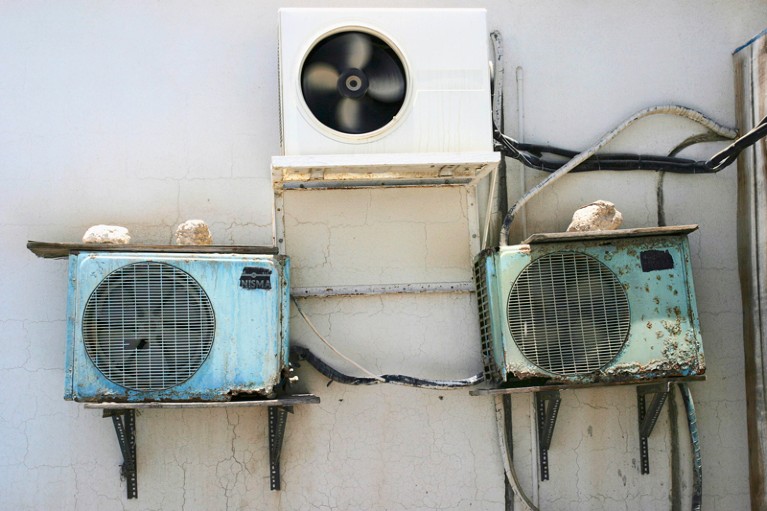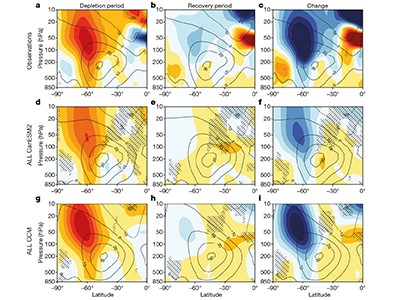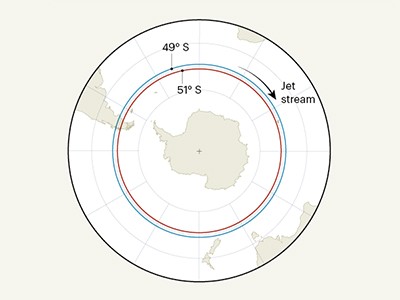
CFCs from older cooling units are not covered by the Montreal Protocol.Credit: Jason Larkin/Construction Photography/Avalon/Getty
In September 1987, many nations came together in Montreal, Canada, in response to an environmental alarm sounded by researchers. The stratospheric ozone layer, which shields the planet from the Sun’s harmful ultraviolet radiation, was disintegrating over Antarctica. The culprit was clear: chlorofluorocarbons (CFCs), a class of chemical used in cooling systems and in products such as spray cans and foam insulation.
That meeting is where the Montreal Protocol on Substances that Deplete the Ozone Layer was adopted — it would be ratified in 1989. CFC emissions fell as countries and corporations rolled out less-damaging chemicals.
Studies1 confirm that the ozone layer has begun its long recovery. And this has strengthened the Montreal Protocol’s reputation as one of the best case studies for science-based policy: researchers identified a looming threat; governments took meaningful action; and the threat began to recede.
Read the paper: A pause in Southern Hemisphere circulation trends due to the Montreal Protocol
But CFCs didn’t just deplete ozone. They have climatic effects, too, as greenhouse gases, and also in that they have changed how air circulates in the Southern Hemisphere — and probably beyond. Now a team led by researchers at the Cooperative Institute for Research in Environmental Sciences in Boulder, Colorado, reports2 in Nature how the Montreal Protocol has been helping to pause — or in some cases possibly reverse – the recent changes in atmospheric circulation driven by ozone depletion. Less ozone meant less absorption of incoming solar energy in the stratosphere. This cooled the lower stratosphere, strengthening the upper-atmospheric winds that circulate around Antarctica during austral summer. But as stratospheric-ozone conditions began to improve around the turn of the millennium, the previous change started to stabilize, and might even have begun to reverse, the researchers found.
This study demonstrates the enduring power of the Montreal Protocol — and of international environmental agreements — to protect the global commons. But another study, published in Nature Communications last week, reminds us why it is vital for researchers to remain vigilant — and why their work is still needed.
International regulations have paused a jet-stream shift in the Southern Hemisphere
There’s no requirement in the Montreal Protocol to find and dispose of older CFC sources — such as old fridges and air-conditioning units — partly because the agreement was about future sources. Also, CFC banks have been regarded as small, but quite how ‘small’ has been the subject of considerable debate and study. Now, researchers from the Massachusetts Institute of Technology in Cambridge report3 that two types of CFC (CFC-11 and CFC-12) are leaking out of old cooling equipment and from building insulation — in greater quantities than had been estimated.
The researchers have calculated that these CFC “banks” are so large that they could potentially delay ozone recovery by six years, also adding the equivalent of nine billion tonnes of carbon dioxide to the atmosphere — similar to the amount that the entire European Union has pledged to cut from its emissions under the United Nations Paris climate agreement. The researchers also found higher-than-expected levels of CFC-113, a chemical previously used in solvents whose direct production is banned.
These latest findings follow research from 2018 and 2019 in which China was traced as a source of illegal CFC-11 emissions. China’s government has reportedly cracked down on this, and the latest analyses — still preliminary — suggest that these emissions have decreased.
Tracking and disposing of older CFC sources will be essential if the Montreal Protocol is finally to achieve its goals. That will need some degree of action by the protocol’s signatory countries — and sooner rather than later. That said, the protocol is a shining example for researchers and policymakers in other domains — not least in climate change — of how scientific evidence can drive global action.

 International regulations have paused a jet-stream shift in the Southern Hemisphere
International regulations have paused a jet-stream shift in the Southern Hemisphere
 Read the paper: A pause in Southern Hemisphere circulation trends due to the Montreal Protocol
Read the paper: A pause in Southern Hemisphere circulation trends due to the Montreal Protocol
 Officials and scientists need help to track down rogue source of CFCs
Officials and scientists need help to track down rogue source of CFCs
 Quantifying contributions of chlorofluorocarbon banks to emissions and impacts on the ozone layer and climate
Quantifying contributions of chlorofluorocarbon banks to emissions and impacts on the ozone layer and climate





